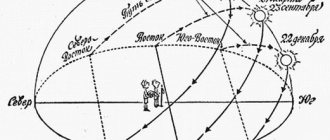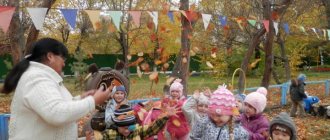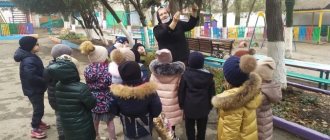Spring walk - observation in kindergarten with middle group children
Summary of a walk in kindergarten in the spring.
Middle group. Observations of the first thawed patches Author: Vitskova Marina Viktorovna, teacher of the MBDOU “Kindergarten “Golden Fish” of the Astrakhan region, Chernoyarsk district. Description: Using this material, children develop observation, curiosity, and attention. This material will be useful for parents and kindergarten teachers when conducting spring walks for middle school children. Topic: “Observing the first thawed patches” Objectives: to develop the ability to find the first signs of spring in the surrounding nature; establish connections between changes in inanimate nature, develop observation skills, and the ability to analyze. Materials: spatulas, buckets, molds, children’s toys for independent activities.
Progress of the walk
Observation of thawed patches.
Educator. Guys, today we will watch the snow melting in different places in the kindergarten area. Show places where snow and ice melt faster. These are the first thawed patches of spring. They appear where the snow warms up better and melts. Thawed patches appear in early spring, when the frosts have not yet completely subsided, and the warm breath of March is already beginning to be felt. Spring is coming towards us with quick steps And the snowdrifts are melting under its feet Black thawed patches are visible in the fields You can see the very warm feet of spring. Educator. Children, what are thawed patches ? (Children's answers) Educator. Thaws are a small area thawed from snow, most often around trees. It seems to many that thawed patches symbolize new life and hope, because they are the first news of spring along with the joyful singing of birds. Educator. Children, what signs do you know about spring ? Children. In spring, day and night are measured and equal. If in early spring the clouds float quickly and high, expect good weather. Frequent fogs in March foreshadow a rainy summer. A dry March means fertility, a rainy March means crop failure. When in the spring the snow melts quickly and the water runs smoothly - towards a wet summer . Educator. Well done, children. Now tell us proverbs and sayings about spring . Children. March is a brother of spring and winter; In March it melts early - it won’t melt for a long time. In spring the rain steams, in autumn it wets. Fear autumn - winter will follow, do not be afraid of winter - spring will follow. Spring is not complete without the first swallow. Whoever works hard in the spring will have fun in the fall. After the most severe winter, spring will still come. In the spring, if you tighten the plowing, you will stretch your legs. Spring is our father and mother; whoever sows will not reap. He who sleeps in spring cries in winter. Prepare the sleigh in the spring and the wheels in the fall. Educator. Well done. Now listen to a poem about spring If the snow is melting everywhere, The day is getting longer, If everything is green and the stream is ringing in the fields, If the wind has become warmer, If the birds can’t sleep, If the sun is shining brighter, It means spring has come to us. Educator. Guys, guess the riddle.
Mystery.
On the river in winter the parquet is durable, slippery, smooth.
At least dance on it for a hundred years! Waltzes and squats. The cold has passed - He disappeared then... Children. This is ice. Educator. That's right, well done.
Now we'll play. A didactic game is being held: “What can’t spring be without?”
Goal: to practice selecting nouns and correct word agreement. Spring cannot exist without... (bright sun). Spring cannot exist without...(puddles). Spring cannot exist without... (streams). Spring cannot exist without... (thunderstorm). Spring cannot exist without...(chafer beetles). Spring cannot exist without... (thawed patches). Spring cannot exist without... (drops). Spring cannot exist without...(snowdrops). Labor activity. “Cleaning up toys” Purpose: to attract children to perform simple tasks. Individual work Development of movements - practice running at speed, improve the technique of standing long jump.
The outdoor game “Homeless Hare” is being played.
Goal: run fast; navigate in space. Progress of the game: A “hunter” and a “stray hare” are selected. The rest of the “hares” stand in hoops - “houses”. The “homeless hare” runs away, and the “hunter” catches up. The “hare” can stand in the house, then the “hare” standing there must run away. When the “hunter” catches the “hare,” he himself becomes the hare, and the “hare” becomes the “hunter.” Independent activity of children.
Summary of the walk.
Educator. Guys, what did we talk about today? What interesting things did you learn? What else would you like to know? (Children's answers)
We recommend watching:
Summary of GCD on speech development in the middle group on the topic: Spring GCD in the middle group of kindergarten on the topic: Spring. Cognitive development Summary of educational activities on speech development “Spring has come” for children of the middle group Summary of educational activities for the middle group of kindergarten on the topic: Spring
Similar articles:
Summary of the lesson “Wild animals in spring” in the middle group
Summary of a spring walk in the middle group
Card index of outdoor games on a spring walk for children of middle preschool age
Anastasia Shvets
Card index of outdoor games on a spring walk for children of middle preschool age
Outdoor games on a spring walk.
Middle preschool age.
“Burn, burn clearly!”
Goal: develop speed and agility
Move: players stand in a column of two, holding hands, in front of the column is the leader. Children say in chorus:
Burn, burn clearly so that it doesn’t go out.
Look at the sky: the birds are flying,
The bells are ringing!
One, two, three - run!
At the end of the words, the players of the last pair lower their hands and run to the beginning of the column - one to the right, the other to the left of it. The driver tries to stain one of the players before he has time to join hands with his partner. If the driver has stained the player, then he pairs up with him at the front of the column.
"Birds and Chicks"
Goal: to develop in children the execution of movements on a signal. Practice running in different directions without touching each other.
Progress: children are divided into 3 - 4 groups; Each group has its own nest house. Each group of “chicks”
there is a mother bird.
According to the teacher’s word “fly”,
the chicks fly out of the nest.
According to the teacher’s word “home,”
the mother birds return and call the chicks home. In the nest, the chicks sit in a circle. The game is played 3 – 4 times.
"Find your color"
Goal: to develop in children attention , the ability to distinguish colors and act on a signal. Practice walking and running.
Progress: children receive flags of three or four colors: red, blue and yellow and are grouped in groups of 4-6 people in different corners of the site. In each corner, the teacher places a colored flag (red, blue, yellow)
.
At the teacher’s signal “go for a walk,”
the children disperse around the playground.
When the teacher says “find your color,”
the children gather near the flag of the corresponding color. Game duration is 4 – 5 minutes.
"Find yourself a mate"
Goal: to develop spatial orientation children Exercise children in running .
Progress: Each child receives one flag. There are equal numbers of flags of two colors. At the teacher’s signal, the children scatter around the playground. On the signal “find a pair”
Children with the same flags stand next to each other.
of children must take part in the game so that one is left without a pair.
Turning to him, all the players say: Vanya, Vanya, don’t yawn (Tanya, Olya and others.)
Choose a pair quickly!
Then, when the tambourine is hit, the children scatter around the playground again, and the game is repeated. Game duration is 5-7 minutes.
"Let's jump over the stream"
Goal: to practice standing long jumps.
Progress: a stream is drawn on the site, narrow at one end, and then wider and wider (from 10 to 40 cm)
A group of
children is asked to jump over a stream, first where it is narrow, and then where it is wider, and finally where it is widest.
Game duration is 5 – 6 minutes. "We are funny guys "
Goal: to develop speed and agility.
Procedure: children stand on one side of the playground outside the line. A second line is drawn on the opposite side of the site. There is a trap in the center of the site. The driver is appointed by the teacher or chosen by the children. The children say in chorus:
We are funny guys
We love to run and jump.
Well, try to catch up with us.
One, two, three - catch it!
After the word "catch"
the children run to the other side of the playground, and the trap catches up with the runners and catches them. The one whom the trap manages to touch before the runner crosses the line is considered caught.
"Run to what I call"
Goal: to train in quickly finding the named object on the site or in the room; develop fast running in a flock, attention.
Move: a driver is selected, the children stand next to him and listen to what he says. The driver explains: “Where I say, you will run there and wait for me. ”
, then says:
“One, two, three, run to the sandbox!”
The driver carefully monitors the children; whoever runs to the wrong object is taken to the penalty box.
The game repeats itself. (children run to the table, to any tree, to the veranda.)
“Cosmonauts”
Goal: to develop children's attention , dexterity, and imagination. Exercise orientation in space.
Progress: the contours of the missiles are drawn along the edges of the platform. The total number of seats in the rockets must be less than the number of children . In the middle of the platform, the astronauts, holding hands, walk in a circle, saying:
Fast rockets are waiting for us
Let's fly to this one!
For walks on the planets .
But there is one secret in the game:
Whatever we want
There is no room for latecomers.
With the last words, the children let go of their hands and run to take their places in the rocket. Those who did not have enough space in the rockets remain at the cosmodrome, and those who are sitting in the rockets take turns telling where they are flying and what they see. After that, everyone stands in a circle again and the game repeats.
Spring dimension
Its goal is to continue acquaintance with various natural phenomena, improve the ability to distinguish weather, and connect it with the features of the sky.
The outline of a walk in the middle group in the spring includes the development of children's attentiveness, maintaining a gracious, joyful, excellent mood, and the formation of concepts about the changing seasons.






